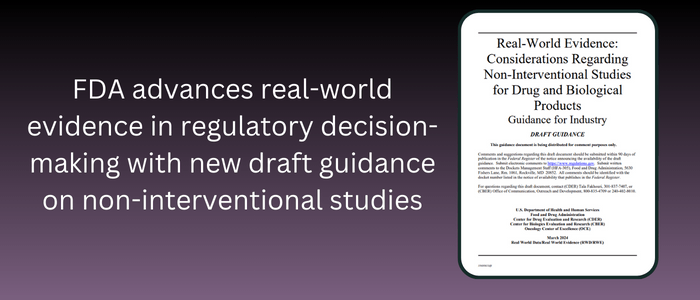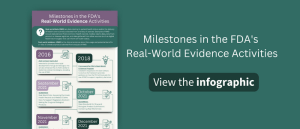FDA advances real-world evidence in regulatory decision-making with new draft guidance on non-interventional studies

A new US FDA draft guidance provides advice for industry on ‘Data Standards for Drug and Biological Product Submissions Containing Real-World Data’, looking to include evidence from non-interventional studies to support the effectiveness or safety of a drug for regulatory purposes.
 View our updated infographic timeline of recent FDA draft and final guidance:
View our updated infographic timeline of recent FDA draft and final guidance:
Infographic: Milestones in the FDA’s Real-World Evidence activities
With a growing demand for guidance on the use of real-world evidence (RWE) in regulatory decision-making, the US FDA has published a new draft guidance focused on non-interventional studies. The guidance, “Real-World Evidence: Considerations Regarding Non-Interventional Studies for Drug and Biological Products,” provides recommendations to sponsors on the design and analysis of non-interventional studies to generate evidence showing the effectiveness and/or safety of a drug. The FDA is issuing the guidance as a requirement outlined in the Federal Food, Drug, and Cosmetic Act (FD&C Act) to provide direction on the incorporation of RWE in regulatory decision-making processes. As noted in the guidance, a non-interventional study can also be termed an observational study and is, “a type of study in which patients receive the marketed drug of interest during routine medical practice and are not assigned to an intervention according to a protocol.” Examples can include cohort studies, case-control studies, and self-controlled studies.
The draft guidance is intended to help sponsors to recognize and tackle common challenges in utilizing non-interventional studies, including identifying and addressing the presence of confounding and other forms of bias. It describes four key attributes of a non-interventional study design and analysis including:
- Summary of the proposed approach, including information on each of the study attributes
- Study design, describing each of the critical elements used to address the research question(s) outlined above
- Data sources, providing details of the proposed data source(s) including relevance, appropriateness and reliability
- Analytic approach, detailing the primary analysis and any secondary analyses
The guidance complements several guidances published by the agency under its Real-World Evidence Program and should be used, “in conjunction with the recommendations in all of these other guidances.” As noted in the guidance, the reliability (accuracy, completeness, and traceability) and relevance (data availability for key study variables and representative of patient numbers) are key for making appropriate causal inferences in non-interventional studies. These also contribute towards the ‘fitness’ of the data for generating RWE to support safety or labeling changes. In this context, sponsors should also consider the guidance provided by the FDA that assess the reliability and relevance of RWD from electronic health records (EHRs) and medical claims data, as well as data from registries.
The FDA also advises that sponsors consult the guidance on data standards for RWD sources and the guidance that describes regulatory considerations for non-interventional studies involving the use of RWD. Notably, the FDA highlight two key points emphasized in previous guidance that are crucial during the planning stage of a non-interventional study: the necessity for (1) predefining study design and conduct; and (2) early collaboration with the FDA to assess the suitability of using a non-interventional study design in the context of the research question.
As documented in the federal register, stakeholders can provide the FDA with comments on the draft guidance on before it is finalized the agency.
Want regular updates on the latest real-world evidence news straight to your inbox? Become a member on The Evidence Base® today>>>






